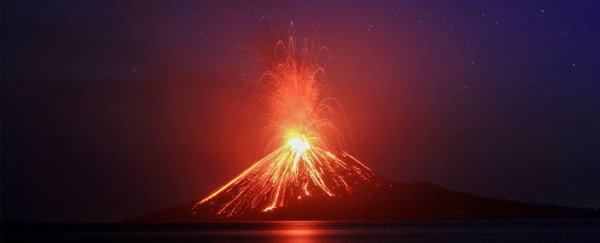The sky was clear and the Moon had risen high, but Captain W.J. Watson of the British ship Charles Bal noticed that the Java Sea had "suddenly assumed a milky-white appearance.
Watson commented that the sky that night - 22 August 1883 - took on a pinkish hue, "as when the Aurora is showing faintly." Then, four days later, the volcanic island of Krakatau was "enveloped in heavy blackness."
"At 3:30 we heard above us and about the island a strange sound, as of a mighty crackling fire," Watson wrote, "or the discharge of heavy artillery at one or two seconds' interval … To us it looked like blinding rain, and had the appearance of a furious squall, of ashen hue."
The volcano's eruption was one of the most catastrophic disasters of modern times. It began in May 1883 and lasted nine months, killing more than 36,000 people.
Most of Krakatau was destroyed in the cataclysm, but another island - Anak Krakatau, or "child of Krakatau" - began forming in 1927 and has erupted several times.
The latest was on Saturday and potentially caused the tsunami that hit coastlines along Indonesia's Sunda Strait and killed more than 200 people.
At the peak of the 1883 eruption, which Watson witnessed from August 26 to 28, Krakatau shot ash 50 miles into the sky and was heard 2,200 miles (3,540 kilometres) away in Australia. A black cloud covered the region and plunged everything into darkness for two and a half days. Smaller eruptions were reported through February 1884.
The whole world felt the effects of Krakatau. The volcanic debris in the air absorbed sunlight, causing global temperatures to plunge more than 2 degrees Fahrenheit (1.1 degrees Celsius).
The particles in the atmosphere also caused extraordinary sunsets. British poet Gerard Manley Hopkins wrote of an evening sky "more like inflamed flesh than the lucid reds of ordinary sunsets."
In Poughkeepsie, New York, firefighters were dispatched after one resident mistook the striking sunset for a fire in the distance.
Some scholars believe that the famous painting "The Scream," by Norwegian artist Edvard Munch, depicts one of the vivid sunsets that resulted in the aftermath of Krakatau's eruption.
Only a portion of Krakatau remained after the explosion. But within decades, Anak Krakatau formed in its remnants.
Read more: A Devastating Tsunami Has Hit Indonesia Without Warning, Killing Hundreds
2018 © The Washington Post
This article was originally published by The Washington Post.
